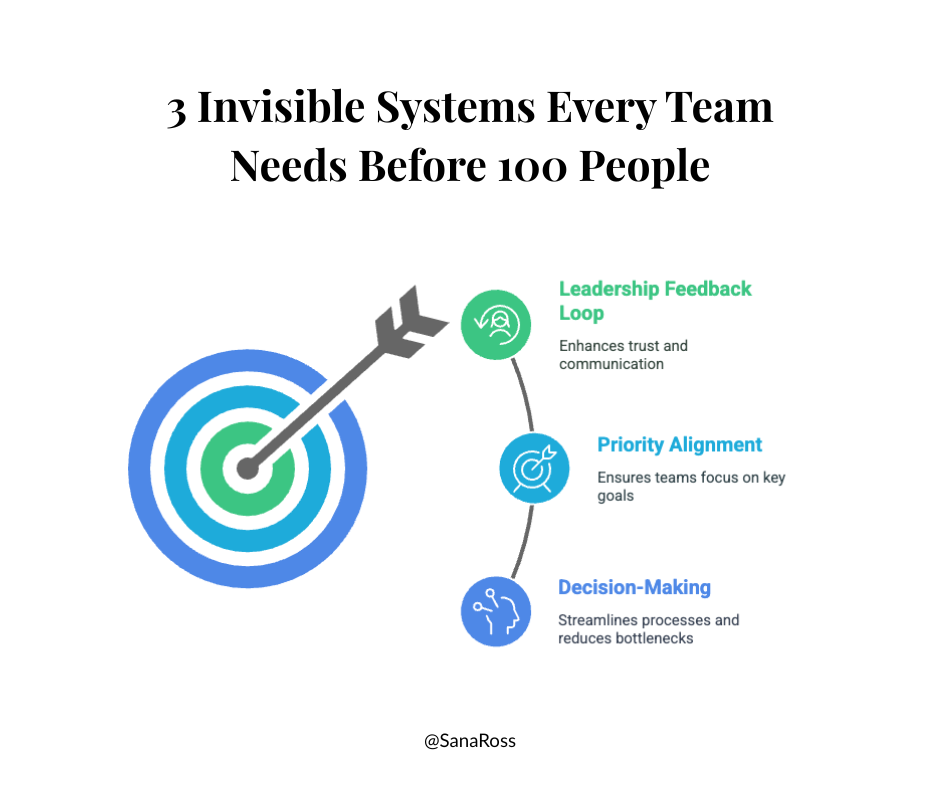The 3 Invisible Systems Every Team Needs Before 100 People
Because scaling isn’t what breaks companies. The lack of structure does.
At 30 people, you still know everyone’s coffee order.
At 50, Slack starts getting weird.
At 75, half your team is asking, “Who owns this?”
By 100, you’re losing good people and wondering when everything got so… blurry.
This is the moment most founders realize: Hiring is easy. Scaling operations without losing your mind (or your team)? Not so much.
If you’re leading, or working in, a company headed toward the triple digits, these are the three invisible systems you need before things break.
Let’s make them visible.
1. The Decision-Making System
“Who’s making the call?” should not be a daily mystery.
When you’re small, decisions happen in hallways, DMs, and adrenaline. When you’re scaling? That turns into confusion, duplication, and silent bottlenecks.
Here’s what happens without a system:
Two teams are building the same thing.
Everyone’s waiting on the founder.
Nobody’s quite sure if a decision was made… or just talked about in Slack.
What to install: A Decision Log
It’s not fancy. It’s just effective.
One shared doc.
Anyone can log a decision they need from leadership.
Decisions are tagged by urgency (🔵 Urgent / 🟡 This Week / ⚪ Later).
CEO or execs review twice a week.
No random Slack pings allowed.
Why it works: You remove 30% of interruptions and 100% of “Sorry, forgot we talked about that.”
2. The Priority Alignment System
If everything’s important, nothing is. Especially at 100 people.
Companies in growth-phase die by distraction.
Not because people aren’t working, but because they’re working on ten different versions of what they think matters.
Without a clear alignment system:
Product is building what sales didn’t sell.
Marketing is launching what ops can’t support.
The founder says “go faster,” but nobody knows where.
What to install: The 3x3 Priority Framework
It’s simple:
3 company-level priorities per quarter.
Each team identifies 3 of their own, tied to the company’s.
Public. Visible. Tracked.
Put it in Notion. Or a whiteboard. Or tattoo it on someone’s forearm. Just don’t let it live in a Google Doc nobody opens after the all-hands.
3. The Leadership Feedback Loop
High-trust teams don’t guess. They talk. And they write stuff down.
At 20 people, you “just know” when something’s off.
At 100, gut checks aren’t enough, you need real systems for keeping leaders aligned and honest.
Without it:
You over-meet and under-communicate.
People smile through meetings and vent in private.
Problems grow in silence, then explode in Q4.
What to install: The Weekly Leadership Loop
1 shared weekly update (written, async, 5–7 bullets per leader)
1 leadership check-in (30 mins max) to unblock and align
1 monthly “trust pulse” — a short survey or 1:1s to catch what metrics don’t show
Why it works: It gives you just enough structure to stay on the same page - without turning into a bureaucracy.
You don’t need these systems to be perfect. You just need them to exist. Because what breaks companies at scale isn’t people.
It’s the absence of systems that protect your people’s brains, time, and trust.
Start now. Before you hit 100 and wonder when things started falling apart.
Pick one system from this list and start small.
You don’t need to roll out some 47-slide Notion doc.
You just need to install something real before the wheels come off at 80 people.
If you’re the one holding it all together, founder, operator, head of people, unofficial Chief of Calm, this newsletter’s for you.

